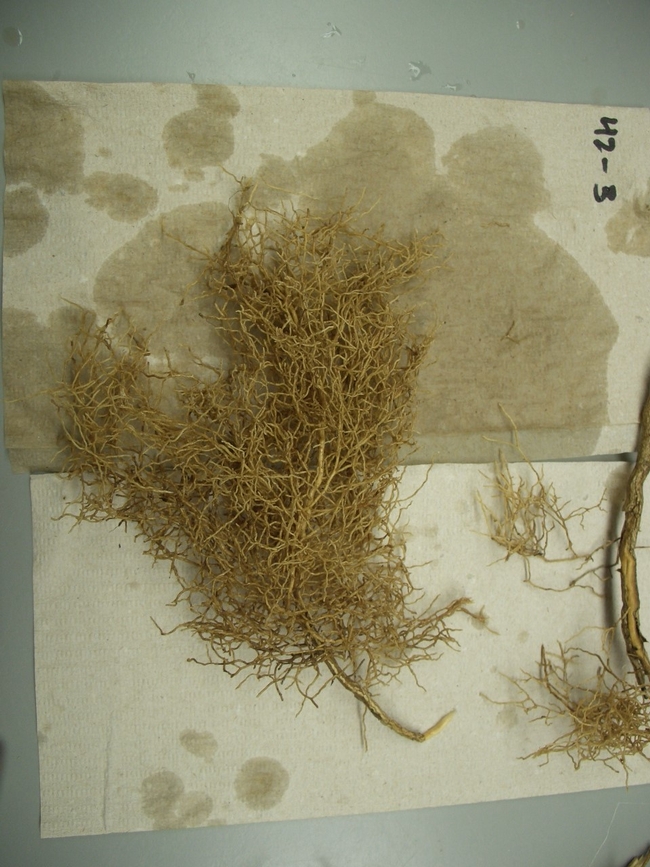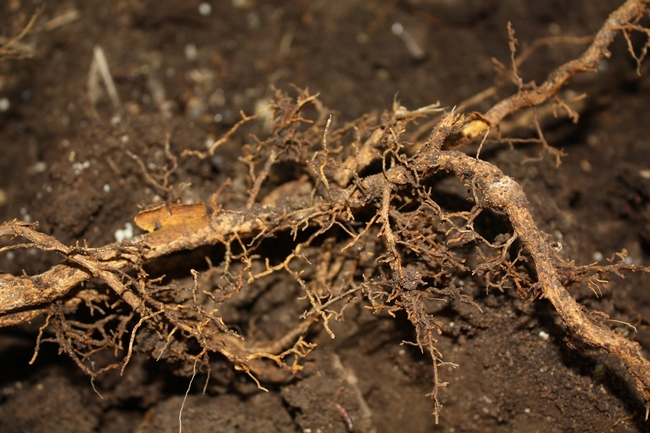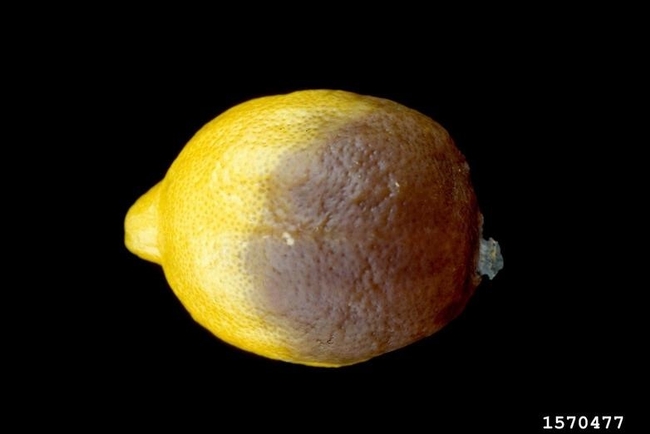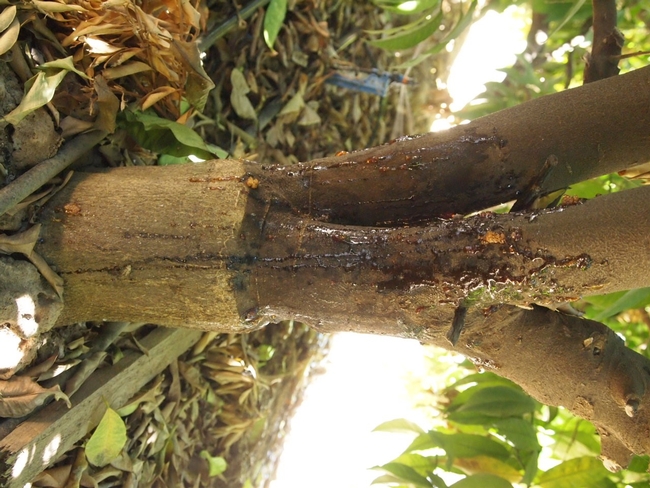Posts Tagged: phytophthora citrus
Lawn-pocalypse! Surviving Drought
Ah, summer! The season of sunburns, pool parties, and… lawn droughts. If your once lush, green carpet now looks like a crunchy brown doormat, you're not alone. Let's dive into why your yard is staging a dramatic death scene and what you can do to...

Bermuda grass and weeds overtaking drought stressed turf grass.
Phytophthora Diseases of CA Citrus
There are at least four species of Phytophthora species (P. citrophthora, P. parasitica, P. syringae, and P. hibernalis) associated with citrus in California and all species can cause various symptoms in citrus including the three main ‘diseases' associated with Phytophthora spp. The three diseases in citrus caused by these fungal-like pathogens are; Phytophthora Root Rot, Phytophthora Brown Rot of citrus fruits both pre-and post-harvest, and Phytophthora gummosis, which causes a canker at the lower area of the tree usually at or around the soil line. These organisms are active within the field essentially all year long so one tree could possibly have all three disease symptoms at one time but this is usually not the situation. These pathogens are also ubiquitous within the soils of California citrus groves so keeping an eye out for these diseases is essential to help manage these citrus issues.
Phytophthora Root Rot (PRR): PRR is caused primarily by P. citrophthora and P. parasitica. The former is most active in the winter with respect to PRR whereas the latter is more active in warm weather so PRR can be found throughout the year. This disease can affect young to mature trees and is often associated with groves that do not have good drainage such as high clay soils. For example, in the Terra Bella area of the San Joaquin Valley, there are areas with high clay soils that lead to problems with PRR due to the lack of drainage which can also lead to additional disease issues such as Dry Root Rot (Fusarium solani). In fact, both pathogens seem to work in tandem because Phytophthora can weaken the trees by destruction of the feeder roots leading to colonization by Fusarium solani and both pathogens can often be isolated in these situations.
Both pathogens are common throughout most citrus grove soils and can survive for years in the soil by producing persistent spores (clamydospores). When moisture is present in the soils, these pathogens can then produce oospores which are the reproductive spore stage. Oospores will differentiate into motile swimming zoospores that are released by the oospores and swim in the free water in the soil towards the primarily feeder roots. These motile zoospores are the infective spores which can decimate the citrus root system leading to potential death of the tree.
Trees that are infected with this disease will often show light green to yellowing of the leaves, thinning of the canopy, and often causes a slow decline of the tree once infected (Fig 1). The trees decline because the feeder roots get destroyed so the plant cannot uptake water and nutrients effectively, thus leading to potential death of the tree. If PRR is the potential suspect of decline, it is possible to dig up roots to evaluate them because this pathogen mostly infects the feeder roots below the soil line within a foot or so from the surface of the soil line. Figure 2 shows what a healthy root system looks like as well as a root system infected by the pathogen. The colonization of the feeder roots is primarily within the root cortex which becomes soft and disintegrates these cells which makes it easy to separate this tissue layer from the stele of the feeder root.
Root rot can also lead to other diseases due to stressing the plants once feeder roots are consumed by Phytophthora. For example, Fusarium solani, which causes dry root rot in citrus is a secondary pathogen that usually only infects citrus once the trees are under stress. Moreover, if the citrus trees are already infected with Citrus tristeza virus (CTV), the combination of CTV and F. solani can play a major role in quick decline of citrus on sour orange rootstock. Other viruses or viroids may also play a role in this interaction but no studies that we are aware of have tested this specifically.
Fig 1. Yellowing and thinning of citrus canopy due to Phytophthora infection.
Figure 2. Healthy root system of a citrus plant (top)
and a root system infected with Phytophthora showing decay of the feeder root system (bottom).
Brown Rot: This disease is caused by the various Phytophthora spp. and is usually associated with mature fruits. However, twigs, leaves, and flowers can also occasionally be infected which can result in death of these tissues. This disease is usually associated with cool and wet conditions. The symptoms can be seen in the field, primarily on low lying fruit because the spores of the pathogen can get dispersed with water and wind and move from the soil to the low-lying fruit in the tree (Fig 3). Therefore, it is recommended to ‘skirt' the trees so that there is no low-lying fruit to get infected. Brown rot can also occur after the fruit is picked (not showing symptoms) so it is also a post-harvest issue as well. In this situation, fruit that does not show obvious symptoms may be picked and stored at the packing house and the disease can spread to healthy fruit during storage.
Fig 3. Brown rot symptoms of Phytophthora on a lemon fruit.
Phytophthora Gummosis (PG): This disease is caused by the various Phytophthora spp. This disease is usually only seen around the soil line to a foot or so above the soil line but could produce a larger canker higher up the trunk (Fig 4). The disease is recognizable because once infected, the tree starts to produce compounds to combat the infection which results in oozing of sap from small infected cracks in the bark which may look as if the tree is bleeding. The bark usually remains firm but dries out and eventually cracks and can slough off the trunk. Sometimes a white crust appearance will also be seen within and around the canker. Once an infection occurs and the tree is not treated, the canker can eventually spread around the circumference of the trunk that can lead to complete girdling of the tree. This can weaken the tree leading to general decline and or kill the tree which can occur within a year under favorable conditions (moist and cool) but usually will take several years of active infection to cause major damage.
Figure 4. Gummosis symptoms on lower trunk of a citrus tree. Note that the scion is more susceptible than the rootstock because most growers use Phytophthora tolerant rootstocks.
General information on control of Phytophthora diseases. If a grower has a field that has had a history of various Phytophthora issues, there is the possibility to do a pre-plant fumigation using metam sodium or chloropicrin. If a grove becomes infected after planting, the most common methods of control are the use of chemicals usually applied through the drip lines. The most common products are Aliette, Ridomil Gold, and Prophyt. In the last several years, another product (Orondis), as well as some other chemistries, have been developed to control Phytophthora diseases. In this study, minimum effective rates to reduce Phytophthora root rot incidence and pathogen soil populations were determined after one and two applications in fall 2016 and summer 2017, respectively, and greenhouse studies confirmed the efficacy of the new fungicides. These findings led to fluopicolide recently receiving a federal and oxathiapiprolin (Orandis) a full registration for use on citrus. The researchers also requested that ethaboxam and mandipropamid also be considered for registration for control of Phytophthora diseases of citrus in CA. These new compounds will provide highly effective treatments and resistance management strategies using rotation and fungicide mixtures for the control of Phytophthora root rot of citrus.
Micronutrient sprays that contain phosphite may also help to control these diseases because this molecule stimulates a systemic inducedresistance response in the citrus trees that helps the plant fight off infections. The new compounds will provide good control when used in a rotation to avoid resistance, as has happened with many older products. For additional information regarding these new options for control of Phytophthora root rot of citrus, see. (https://apsjournals.apsnet.org/doi/10.1094/PDIS-07-18-1152-RE).
More details on Phytophthora and its control can be found at the UC IPM website; https://www2.ipm.ucanr.edu/agriculture/citrus/?src=redirect2refresh.
Climate-Change Resources
University of California UC ANR Green Blog (Climate Change and Other Topics) https://ucanr.edu/blogs/Green/index.cfm?tagname=climate%20change (full index)
Examples:
- Save Trees First: Tips to Keep Them Alive Under Drought https://ucanr.edu/b/~CdD
- Landscaping with Fire Exposure in Mind: https://ucanr.edu/b/~G4D
- Cities in California Inland Areas Must Make Street Tree Changes to adapt to Future Climate https://ucanr.edu/b/~oF7
Drought, Climate Change and California Water Management Ted Grantham, UC Cooperative Extension specialist (23 minutes) https://youtu.be/dlimj75Wn9Q
Climate Variability and Change: Trends and Impacts on CA Agriculture Tapan Pathak, UC Cooperative Extension specialist (24 minutes) https://youtu.be/bIHI0yqqQJc
California Institute for Water Resources (links to blogs, talks, podcasts, water experts, etc.) https://ciwr.ucanr.edu/California_Drought_Expertise/
UC ANR Wildfire Resources (publications, videos, etc.) https://ucanr.edu/News/For_the_media/Press_kits/Wildfire/ (main website)
-UC ANR Fire Resources and Information https://ucanr.edu/sites/fire/ (main website)
-Preparing Home Landscaping https://ucanr.edu/sites/fire/Prepare/Landscaping/
UC ANR Free Publications https://anrcatalog.ucanr.edu/ (main website)
- Benefits of Plants to Humans and Urban Ecosystems: https://anrcatalog.ucanr.edu/pdf/8726.pdf
-Keeping Plants Alive Under Drought and Water Restrictions (English version) https://anrcatalog.ucanr.edu/pdf/8553.pdf
(Spanish version) https://anrcatalog.ucanr.edu/pdf/8628.pdf
- Use of Graywater in Urban Landscapes https://anrcatalog.ucanr.edu/pdf/8536.pdf
- Sustainable Landscaping in California https://anrcatalog.ucanr.edu/pdf/8504.pdf
Other (Non-UC) Climate Change Resources
Urban Forests and Climate Change. Urban forests play an important role in climate change mitigation and adaptation. Active stewardship of a community's forestry assets can strengthen local resilience to climate change while creating more sustainable and desirable places to live. https://www.fs.usda.gov/ccrc/topics/urban-forests
Examining the Viability of Planting Trees to Mitigate Climate Change (plausible at the forest level) https://climate.nasa.gov/news/2927/examining-the-viability-of-planting-trees-to-help-mitigate-climate-change/
Reports and other information resources coordinated under the auspices of the United Nations and produced through the collaboration of thousands of international scientists to provide a clear and up to date view of the current state of scientific knowledge relevant to climate change. United Nations Climate Action
Scientific reports, programs, action movements and events related to climate change. National Center for Atmospheric Research (National Science Foundation)
Find useful reports, program information and other documents resulting from federally funded research and development into the behavior of the atmosphere and related physical, biological and social systems. Search and find climate data from prehistory through to an hour ago in the world's largest climate data archive. (Formerly the "Climatic Data Center") National Centers for Environmental Information (NOAA)
Think tank providing information, analysis, policy and solution development for addressing climate change and energy issues (formerly known as the: "Pew Center on Global Climate Change"). Center for Climate & Energy Solutions (C2ES)
Mapping Resilience: A Blueprint for Thriving in the Face of Climate Disaster. The Climate Adaptation Knowledge Exchange (CAKE) was launched in July 2010 and is managed by EcoAdapt, a non-profit with a singular mission: to create a robust future in the face of climate change by bringing together diverse players to reshape planning and management in response to rapid climate change. https://www.cakex.org/documents/mapping-resilience-blueprint-thriving-face-climate-disaster
Cal-Adapt provides a way to explore peer-reviewed data that portrays how climate change might affect California at the state and local level. We make this data available through downloads, visualizations, and the Cal-Adapt API for your research, outreach, and adaptation planning needs. Cal-Adapt is a collaboration between state agency funding programs, university and private sector researchers https://cal-adapt.org/
Find reports, maps, data and other resources produced through a confederation of the research arms of 13 Federal departments and agencies that carry out research and develop and maintain capabilities that support the Nation's response to global change. Global Change (U.S. Global Change Research Program)
The Pacific Institute is a global water think tank that combines science-based thought leadership with active outreach to influence local, national, and international efforts to develop sustainable water policies. https://pacinst.org/our-approach/
Making equity real in climate adaptation and community resilience policies and programs: a guidebook. https://greenlining.org/publications/2019/making-equity-real-in-climate-adaption-and-community-resilience-policies-and-programs-a-guidebook/
Quarterly CA Climate Updates and CA Drought Monitor Maps (updated each Thursday) https://www.drought.gov/documents/quarterly-climate-impacts-and-outlook-western-region-june-2022
Excessive Rain Promotes Phytophthora Diseases in Citrus Orchards
California is in a severe winter storm making conditions ideal for diseases caused by Oomycetes, also called water molds, especially Phytophthora species, which thrive in waterlogged soils and areas with standing water for periods of time. During moist conditions, large numbers of motile zoospores, which can swim in water for short distances, are produced. Zoospores are carried in irrigation or rainwater to the fruit, crown, and roots. Inoculum levels and wetness length are the most important predictors of brown rot epidemics. Unfortunately, Phytophthora species can be found on most orchards in the state. They cause trunk canker, gummosis, and crown, root, and fruit rots on citrus.
To manage Phytophthoradiseases, moisture management is foremost. Control of Phytophthora diseases are extremely difficult, even with the use of fungicides, in the wet weather conditions. In the past few years, researchers from UCR have work on a number of new fungicides, with new active ingredients, to be used in the management of Phytophthora diseases. Management of Phytophthora diseases can also be accomplished through cultural control. It is important to improve soil drainage. Adequate drainage includes both surface and subsoil drainage. Surface drainage is necessary to remove excess surface water rapidly during and after heavy rains. This is usually accomplished by
planting on bedding unless the natural topography has a slop and diverting surface water into collection ditches. Rain water that soaks into the soil and raises the water table must be removed by subsurface drainage. This can be done through the use of subsurface drains or open ditches.

Fungicide treatment phytophthora
Drought focus of Water Resources IMPACT magazine special issue
UC ANR experts address emotional toll of drought
Preparing the American West for prolonged drought is the focus of a double issue of Water Resources IMPACT magazine. The California Water Commission staff are guest editors for this special open-access edition of the magazine, which is published by the American Water Resources Association.
Faith Kearns, academic coordinator of University of California Agriculture and Natural Resources' California Institute for Water Resources, is among the authors delving into how drought impacts people and the environment and how we can better prepare for the inevitable.
The first issue, published on Feb. 14, focuses on water scarcity issues confronting California and the ways these issues affect different sectors.
In “Trauma, Care, and Solidarity: Addressing the Emotional Toll of Chronic Drought,” Kearns highlights the effects of drought on mental health. She points to the spike in suicide hotline calls when wells ran dry in Southeast Asian communities in California's Central Valley.
By listening to Southeast Asian farmers, Ruth Dahlquist-Willard and Michael Yang of UC Cooperative Extension were able to “lighten the load” for them by providing pragmatic support, Kearns writes.
“The scale of some of these highly emotional issues – drought, wildfires, climate change – can make them seem incredibly difficult, if not impossible, to deal with,” Kearns said. “At the same time, they are affecting everyone living in the western U.S. on a daily basis. I wanted to highlight and provide models based on work that people – whether they are researchers, clinical psychologists, or Cooperative Extension advisors – are doing right now to ease the way.”
The authors who contributed to the double issue are a diverse array of Tribal experts, academics, nongovernmental organization thought-leaders, water managers and water policy influencers, each of whom brings their own perspective on the topic of drought. Their expertise and perspectives in climate science, water policy and water management will help inform drought-related decision-making and support policies that better prepare the state to thrive during periods of prolonged water scarcity.
In addition to Kearns, the first issue includes articles contributed by:
- Samantha Stevenson, University of California, Santa Barbara
- Jay Lund, University of California, Davis
- Ron Goode, North Fork Mono Tribe
- Andy Fecko, Placer County Water Agency
- Jeff Mount, Public Policy Institute of California, and Ted Grantham, University of California, Berkeley/UC Cooperative Extension
- Nat Seavy and Karyn Stockdale, National Audubon Society
- Kjia Rivers, Community Water Center
- Cannon Michael, Bowles Farming
- Michelle Reimers, Turlock Irrigation District
The January/February edition of Water Resources IMPACT magazine can be accessed, free of charge, on the American Water Resources Association website at https://www.awra.org under “Publications.”
The second issue, to be published in March, will focus on drought response, considering the options for adaptation. This two-part series complements the Commission's work on strategies to protect communities and fish and wildlife in the event of a long-term drought.








